Day 1 of a three day Autumn Migration tour today. It was a glorious sunny day, warm with light SE winds. Lovely weather to be out and about, if a little too good for bringing in tired migrants!
Our first destination for the morning was Snettisham. As we drove across towards the Wash coast, we passed some old farm buildings beside the road. A shape in the frame of an old window caught our eye – a Little Owl looking out. It had been rather cool overnight and it had found a spot in the morning sun to warm itself. A nice start to the day.

A little further on, and a Red Kite flew up from beside the road together with a dark chocolate brown juvenile Marsh Harrier, presumably from some carrion nearby. They crossed the road low just in front of us. Just beyond, a Common Buzzard perched on a hedge was enjoying morning sun.
As we made our way down towards the Wash at Snettisham, there were several Little Egrets on the pits. There were three Common Gulls in with the Black-headed Gulls and, as ever, lots of Greylag Geese.
It was not one of the biggest high tides today, not enough to cover all the mud, but it was going to push a lot of the birds up towards the shore. When we got up onto the seawall, we could see the tide was already well in. The mud along the edge of the water was covered in birds – a dark slick of Oystercatchers and the bright grey/white of Knot in their thousands, catching the sunlight.
The Knot were all rather jumpy, occasionally flying up and swirling round out over the water. We could see what looked like clouds of smoke further out, over the middle of the Wash, but on closer inspection they were more Knot, tens of thousands of them. Something was obviously spooking them, but it meant we were treated to a great show!
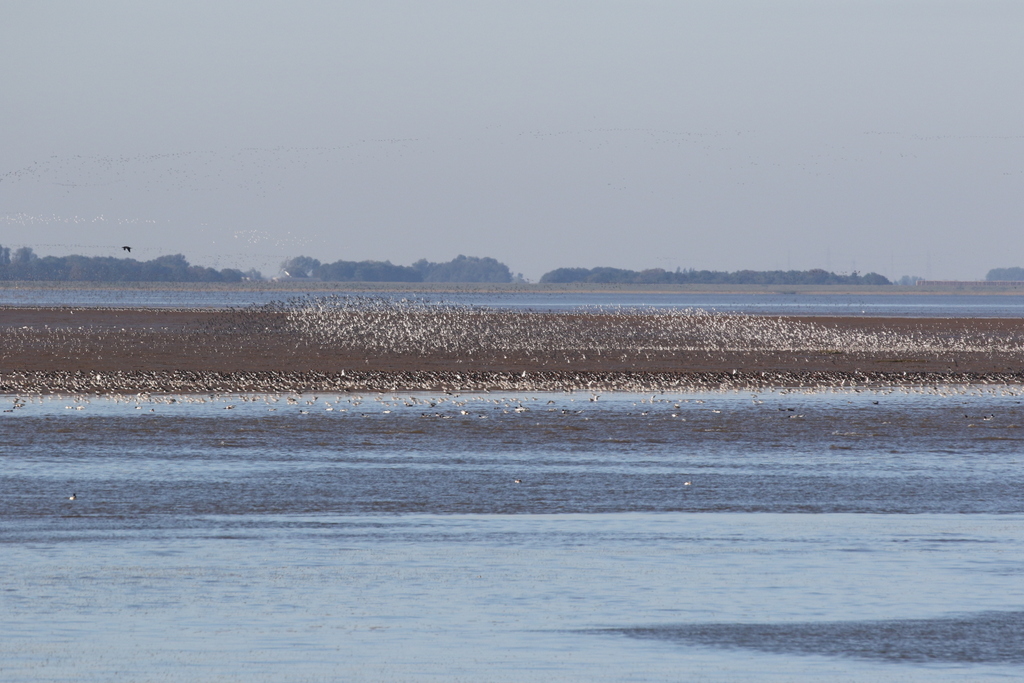
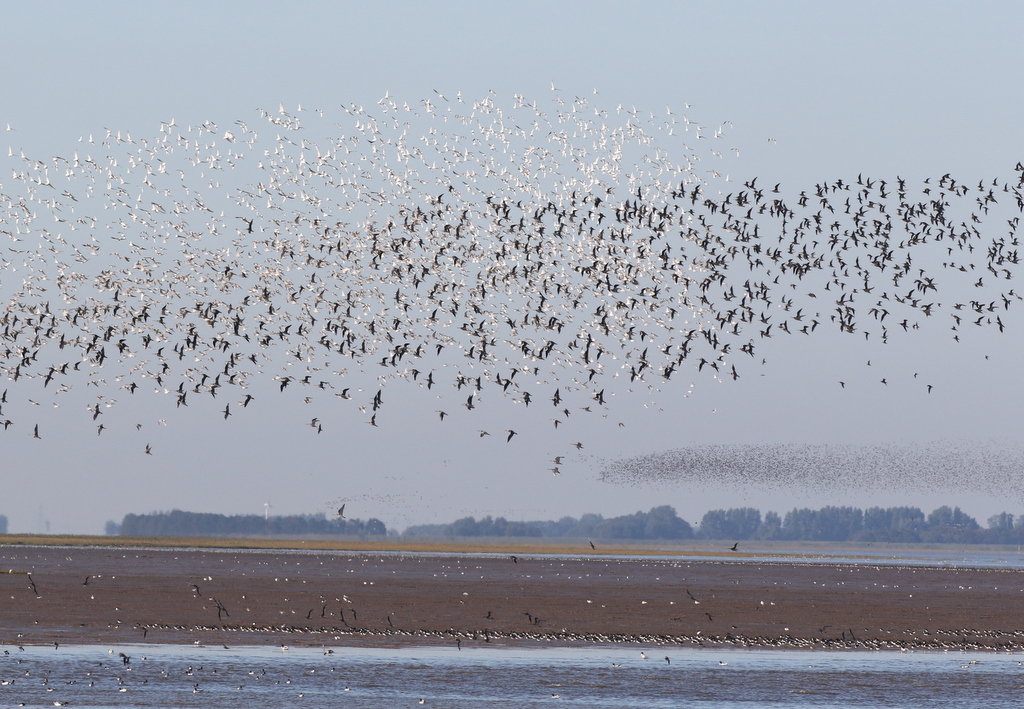
When the waders settled again, we had a closer look through the scope. In with all the Knot and Oystercatchers, we could see lots of Bar-tailed Godwits too. Higher up, on the drier mud, the Curlews were more sparsely scattered, still hundreds of them, mostly asleep on one leg with their long bills tucked in their backs.
Little groups of smaller waders were flying in and landing down along the near edge, on the mud in front of us. There were several Ringed Plovers and Turnstones, and one or two Knot with them, giving us a closer look than the vast flocks further back. Looking further up the shore, we could see a small group of silvery-white Sanderling scurrying around on the sandy spit. A few Sandwich Terns flew back and forth calling, along with a single Common Tern.

There were a few hirundines moving today, little groups of Swallows, but in the bright and sunny conditions many were going over high, particularly the House Martins. They are leaving us now, heading off south on their way to Africa for the winter.
While we were scanning the sky, we picked up a small flock of geese, very distant. They were flying high, very different from the local Greylags, smaller and shorter-necked too. They were heading our way and once they got within earshot, our thoughts were confirmed and they were Pink-footed Geese. Eventually they came right overhead, and out over the Wash. There were a few Brent Geese, freshly returned from Russia for the winter, and several Pintail out on the Wash too.

Further down along the seawall, we found two Greenshanks on the pit just north of the causeway. They were busy feeding, much paler, more elegant than the Common Redshank which was with them. A Common Sandpiper flew in and we watched it creeping along the far bank, in and out of the reeds on the edge. We could see the distinctive notch of white extending up between the grey breast and wings.
There were a few Wigeon on here too, our first of the tour. Looking down over the other pit, to the south, we were looking into the sun but we could see a Spoonbill roosting in with the Greylags and Cormorants out in the middle and what looked like two Spotted Redshanks next to it. They were distant from here and we were looking into the sun, so we decided to walk down to Shore Hide.
On our way, we scanned the Wash again. We could see some very distant Grey Plover with the remnants of their black summer bellies and a little group of Dunlin. Both additions to our wader list, although we would have better views of them later.
From Shore Hide, we had a much better view of the Spoonbill. It was mostly doing what Spoonbills seem to like doing best – sleeping! But it did wake up eventually, showing us its spoon-shaped bill. It was a juvenile, with a dull fleshy-coloured bill lacking the adult’s yellow tip. Then it suddenly flew off, down the pit and back out towards the Wash. The two Spotted Redshanks with it were also asleep, but another one a little further over with another group of geese on the next islands was awake, so we could see its distinctive long, needle-fine bill.

With the tide not covering the mud, there were not the huge hordes of waders roosting on here today, although one of the islands further up was fairly packed with Common Redshanks and we could see more waders down at the south end. There were lots of geese, mainly Greylags, with several Canada Geese, including a mixed pair with four Canada x Greylag hybrid juveniles. There were a few Egyptian Geese too, and ducks including a few Gadwall, Teal, Shoveler and three Tufted Ducks. A couple of Little Grebes were busy diving.
Someone in the hide told us they had seen a Whinchat further down, so we decided to walk down to South Hide to have a look. We stopped to scan the bushes where it had been, but there was no sign of it at first. In the sunshine, we could see lots of raptors circling up – several Marsh Harriers, one or two Common Buzzards over, and a couple of Kestrels hovering. One of the Marsh Harriers flushed a Peregrine out on the saltmarsh, which flew round and landed on a post off in the distance.
Two large corvids flying in from the edge of the Wash immediately looked different, large-billed, heavy headed, with thick necks – two Ravens! They started to circle, and we could hear their kronking calls, before they gradually drifted off inland and we lost sight of them behind the trees. Ravens are still very scarce in Norfolk, so this was a very welcome bonus.
We found two Stonechats first, on the suaeda bushes out on the edge of the saltmarsh, then a Whinchat appeared with them. They kept dropping down into the vegetation out of view or over the far edge of the bushes where we couldn’t see them, but there seemed to be more Stonechats now, at least four. The Whinchat seemed to be favouring a larger dead elder bush which provided a good vantage point and just as it looked like a second Whinchat joined it, a Kestrel dropped down and landed in the bush flushing them. We had a nice view of the Kestrel in the scope though.
Round at South Hide, we could see the islands here were full of Black-tailed Godwits. Most of the adults are now in drab grey-brown non-breeding plumage but a few still had remnants of their brighter rusty feathers and several juveniles were also more brightly coloured too. Most of the Avocets have gone south now, but four were lingering with them, including a brown-backed juvenile which fed in the small pool down at the front. A Little Egret walked across below the hide, its yellow feet flashing in the sunshine.
After walking back to the minibus, we made our way round to Titchwell. We cut across inland, where we started to flush Jays from the hedgerows, flying along in front of us flashing their white rumps. There seemed to be lots of Jays on the move up here today, following the ridge.
Round at Titchwell, we stopped for lunch in the picnic area. We could hear a Great Spotted Woodpecker calling and had a brief glimpse of it flying through the tops of the trees. Afterwards we headed out onto the reserve. A family of Greenfinches was calling up in the birches above the feeders.
There were lots of Bearded Tits calling in the reeds from the main path, but they were keeping down today. A Cetti’s Warbler was singing, and also typically kept itself well hidden. There were lots of Common Pochard diving on the back of the Reedbed Pool, along with a couple of Tufted Ducks. Out on the saltmarsh opposite, a Curlew was very well camouflaged in the vegetation, more so than the Lapwings.
While we were standing by the reedbed, eleven Spoonbills flew up from the Freshmarsh beyond. It looked like they might head off south, but they turned over the reeds and flew straight towards us, coming right overhead, before heading out over the saltmarsh. They circled round and eventually landed, so we could get them in the scope. Mostly adults here, with yellow-tipped bills.
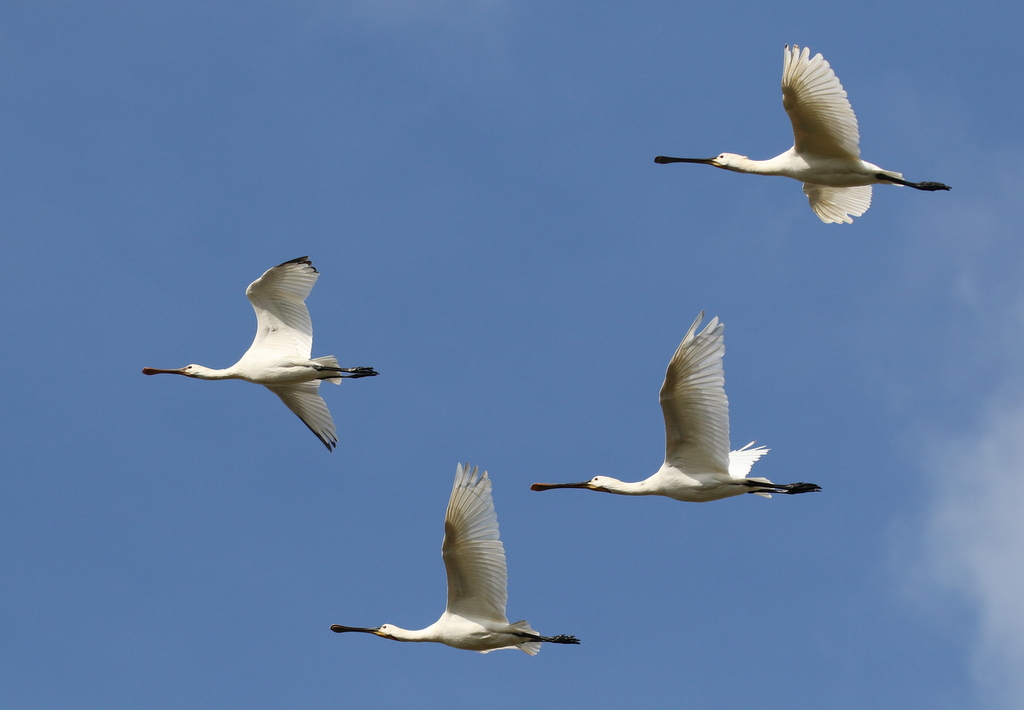
There were more Bearded Tits calling from the reeds on the edge of the Fresmarsh, but there was still no sign from the main path. We decided to have a look from Island Hide, and were immediately rewarded with two feeding down low along the edge of the reeds opposite the hide. We stopped to watch and realised their were several along the edge of the mud. We had good views of several males, with their powder blue-grey heads and black moustaches, and the browner females.
A Common Snipe was feeding further back, on the mud in front of the reeds, and a Water Rail put in a brief appearance before scuttling back into the reeds.
There was a good selection of waders on the Freshmarsh again today, still lots of Ruff and Dunlin. A single juvenile Little Stint was rather mobile, but we had a good look at it through the scope, feeding with a Dunlin at one point for a good comparison, the Little Stint noticeably smaller, shorter billed, cleaner white below. When it flew again, we lost track of it.
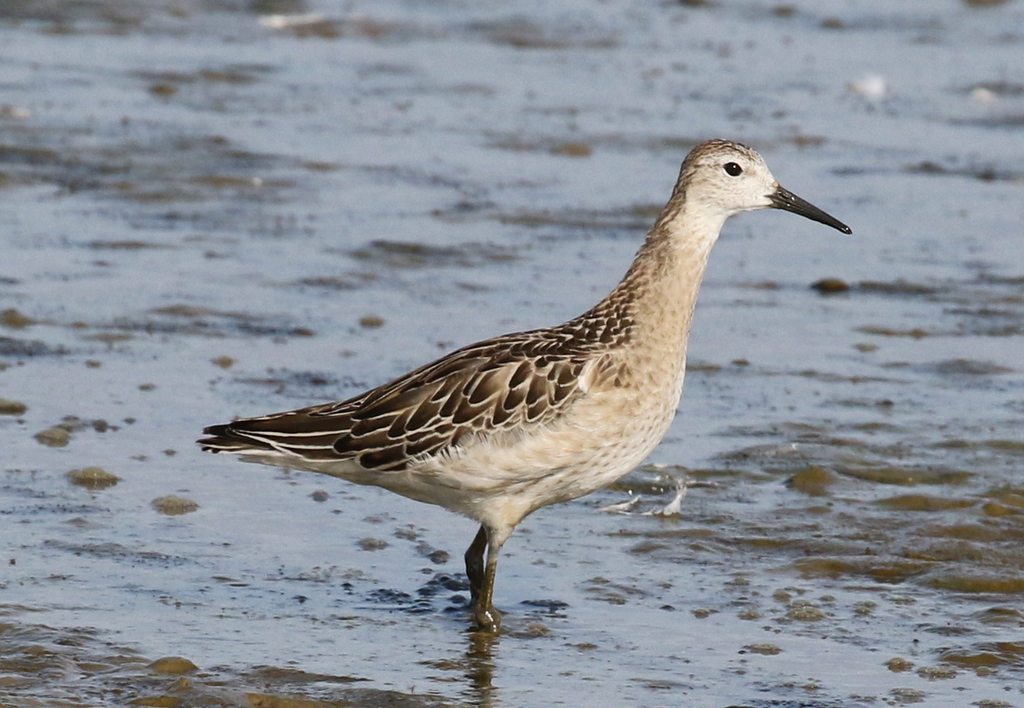
There were quite a few Lapwings and Golden Plover asleep on the islands out in the middle. Two or three Ringed Plovers were running around on the drier mud, over towards the west bank path. A Little Ringed Plover flew in and landed on the mud on the edge of the reeds.
There were lots of gulls loafing on the islands too, mostly Black-headed Gulls but with a few Herring Gulls and Lesser Black-backed Gulls with them. At least four Mediterranean Gulls were initially well hidden in the Black-headed Gulls behind the low brick wall, but eventually came out and one adult even stood up on the bricks at one point which allowed everyone to get a better look at it.
A Great White Egret flew over and disappeared off towards Thornham. There were still two Spoonbills left on the Freshmarsh, and a couple more started to filter back from the saltmarsh. A Yellow Wagtail dropped in right in front of the hide and spent a couple of minutes running back and forth before flying off calling shrilly.

As we came out of the hide, we could hear a tit flock in the sallows just behind the hide, Long-tailed Tits and Blue Tits. From the ramp up to the west bank path, we had a great view of them feeding in the branches in the sunshine.
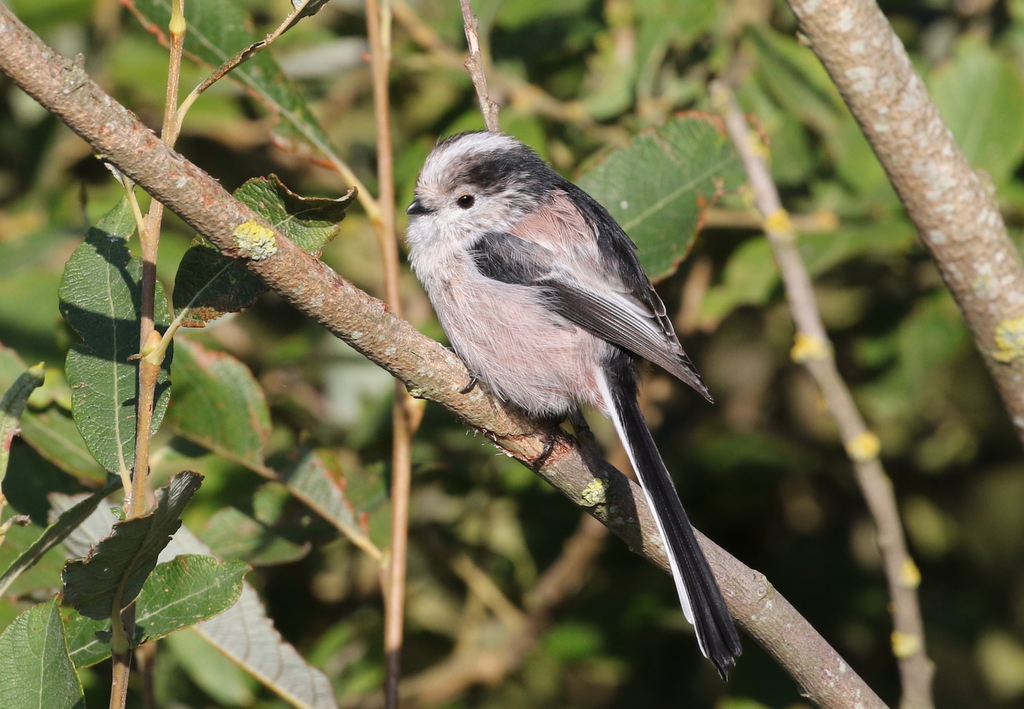
We decided to head out towards the beach. From up on the bank, we could now see a Spotted Redshank right in the back corner of the Freshmarsh. Continuing on, there were just a few Redshanks and Curlews on Volunteer Marsh and with the tide out now there was nothing on the Tidal Pools.
Scanning from the top of the beach, we could see a few very distant Great Crested Grebes on the sea but not much else. There were lots of waders on the mussel beds, so we walked down for a closer look. We had much better views of Bar-tailed Godwits from here, after the distant ones out on the Wash. One was bathing in a small pool on the beach just behind the mussel beds and we had a good look at it through the scope. At one point, a Black-tailed Godwit was in the same scope view, giving us a good comparison between them.
We realised that time was running out and we had to head back. We had a message to say there was a Wheatear on the Freshmarsh, so we stopped to have a look for it. The vegetation on Avocet Island is quite tall, although it is in the process of being strimmed. The Wheatear was probably feeding on the newly cut area, as it eventually showed itself on one of the fence posts, before it was chased off by a Pied Wagtail.
The Little Stint had reappeared again, so we had another good look at that. Then a single Pink-footed Goose flew in calling, and dropped down with the Greylags loafing on one of the closer islands. It wasn’t made to feel welcome! It found a spot on the edge of the other geese and settled down, possibly fresh in and needing a rest. It was a great view through the scope, the Pink-footed Goose smaller than the Greylags, darker headed, with a more delicate bill, mostly dark with a pink band in the middle.
We had to tear ourselves away, as some of the group had to be back, but still we weren’t finished. As we walked back towards the visitor centre, we glanced across to the sallows and noticed a small pale bird perched in the leaves in the sunshine. It was very plain faced, with a dark eye and pale eye ring, a Redstart. From the right angle, we could see its orange-red tail.
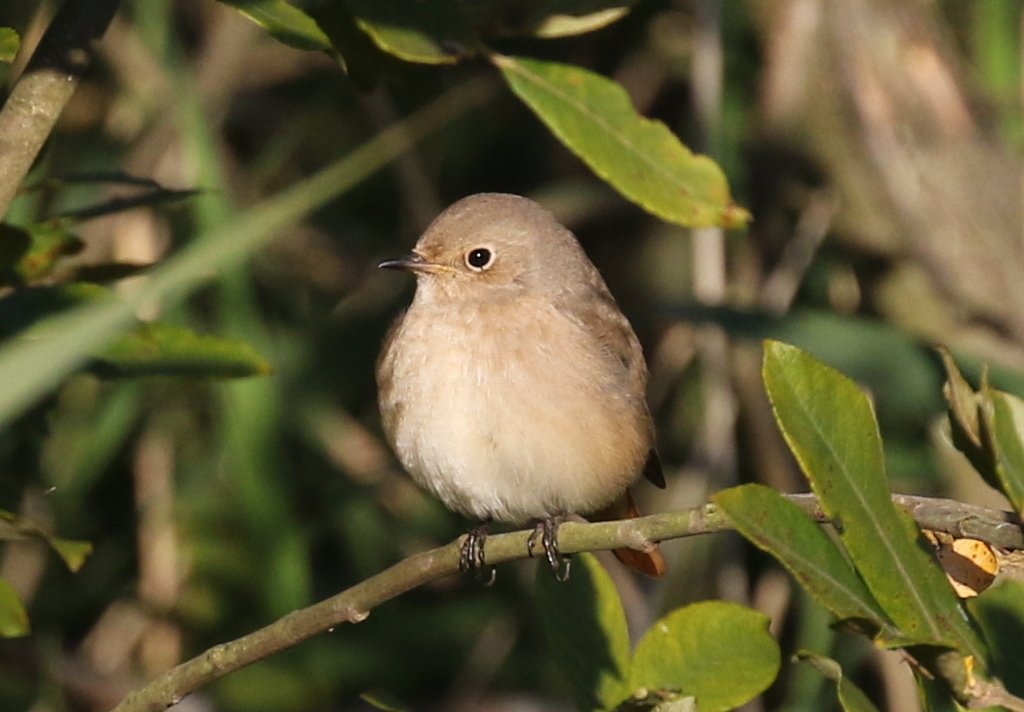
Redstart is a migrant here, stopping off on its way south from Scandinavia in autumn, heading for Africa. It looked like this one might be fresh in, tired and enjoying a rest in the sun, as it was unconcerned at first by all the people walking past and us stopping to watch it. It was a great way to end our first day. Back in the car park, as we packed up, a little flock of Swallows flew over, more Autumn migrants on their way.
















